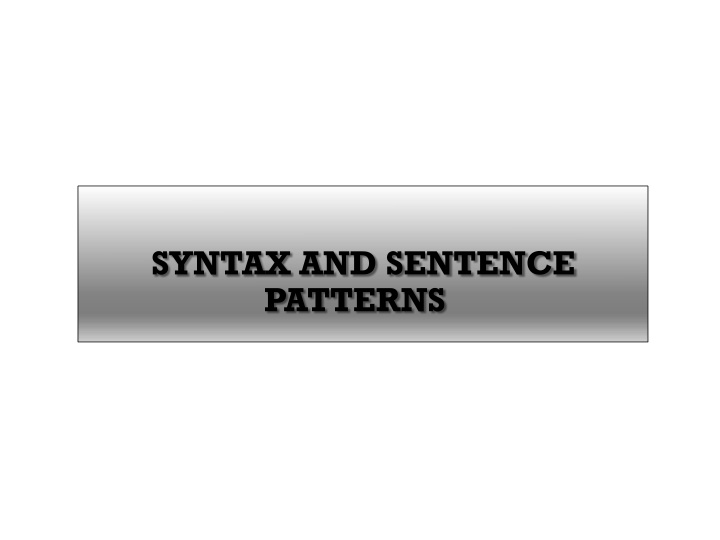
Unraveling Sentence Patterns and Syntax Analysis
Discover the world of syntax and sentence patterns, understand how linking words connect constituents, and delve into the analysis of sentence structures through constituent analysis. Explore the use of different linguistic devices in organizing words and constituents to decipher the essence of language.
Download Presentation

Please find below an Image/Link to download the presentation.
The content on the website is provided AS IS for your information and personal use only. It may not be sold, licensed, or shared on other websites without obtaining consent from the author. If you encounter any issues during the download, it is possible that the publisher has removed the file from their server.
You are allowed to download the files provided on this website for personal or commercial use, subject to the condition that they are used lawfully. All files are the property of their respective owners.
The content on the website is provided AS IS for your information and personal use only. It may not be sold, licensed, or shared on other websites without obtaining consent from the author.
E N D
Presentation Transcript
SYNTAX AND SENTENCE PATTERNS
OVERVIEW Linking Words Together Constituents Analysis
LINKING WORDS TOGETHER Different languages use different devices for showing the relationship of one word to another. Most languages have one or two favorite devices. The most common devices are: word order, inflection and function words. Languages that rely heavily on word order are known as configurational languages.
LINKING WORDS TOGETHER Non- configurational languages rely heavily on Inflection. Inflections indicate the relationship between words. Heavily inflectional languages have complicated morphology. For example Arabic, Latin, and French can indicate the relation ship between different words by inflectional affixes.
LINKING WORDS TOGETHER The other common linguistic device to mark syntactic relations between words is the use of function Words Defining what a function word can be rather problematic. Part of the problem is that several English words, such as to, can be used both as a function word, and as a content word. Consider the examples below: 1. Paul wants to go home. (function word) 2. Peter went to the river. (content word towards , as far as )
CONSTITUENTS ANALYSIS Sentences comprise smaller component parts, i.e. constituents. These constituents are combined together in non-random ways that are called sentence patterns. Sentence patterns can be identified by a process of successive substitution of the sentence constituents. The test of substitution is fundamental to constituent analysis, though the process is not always as straightforward.
CONSTITUENTS ANALYSIS The linguistic procedure which divides sentences into their component parts or constituents, by means of successive substitution, is known as constituent analysis. Consider the sentence below, which can be analyzed in different ways: The mechanic repaired the car 1. It has five different components (words). 2. It has three different grammatical parts (Subject, verb and object). 3. It has two different constituents ( a noun phrase and a verb phrase).
CONSTITUENTS ANALYSIS Languages vary in the devices they use to organize words and constituents together. Since constituents have a finite number of patterns, they behave in predictable ways. It is therefore possible to build up a store of specific tests for the presence or the absence of a particular constituent in a given language, and eventually to identity the constituents of a given sentence.
CONSTITUENTS ANALYSIS For instance noun phrases in English recur in certain specifiable positions, the most important of which are: 1. At the beginning of a sentence before the verb: The cat ate the canary. 2. At the end of a sentence after the verb: The canary feared the cat. 3. After by in a passive sentence: The canary was eaten by the cat. 4. After an auxiliary verb in questions: Did the cat eat the canary?


















